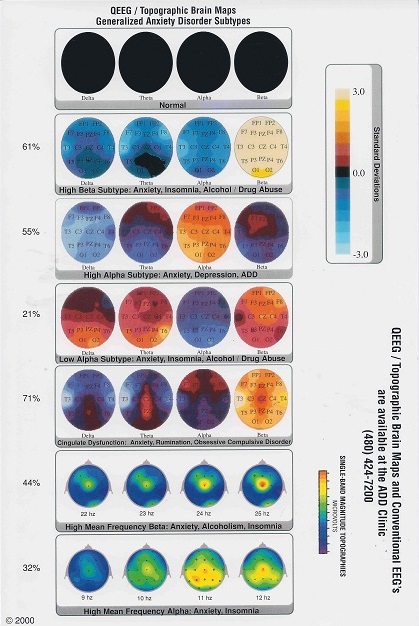[custom_frame_left]

[/custom_frame_left]Anxiety is no fun and causes needless suffering. There are two types of anxiety: 1) cognitive and 2) physiological. Cognitive anxiety is excessive worry and fear, and difficulty turning them off. Physiological anxiety is from hyperarousal: restlessness, nervousness, insomnia, irritability and feeling tense or wired.
Robert Gurnee, MSW, director of the Scottsdale Neurofeedback Institute, completed groundbreaking research by reviewing the QEEG Topographic Brain Maps of 100 patients with high levels of anxiety. He found six subtypes, some primarily the cognitive excessive worrying subtype and some with the physiological hyper-arousal worrying subtype. Most patients had a combination of the QEEG subtypes and suffered from both excessive worry and hyper-arousal. The QEEG Brain Map can help predict medication response or non-response and can be used to plan EEG Neurofeedback training interventions to retrain the brain to decrease the abnormal patterns. For example, as the excessive Beta subtype (hyper-arousal) is trained down, patients begin to sleep better, and feel more relaxed and calm and less irritable. Training down elevated Theta in the cingulate enables people to learn to increasingly turn off their worries at will. When finished, there is usually no need for medication, and the results are usually long lasting.
The image below shows the Anxiety subtypes that were discovered from the research. You will see that the top map, which is all black, represents a normal working brain. This map is zero deviations from the New York University Medical School Database. The remaining maps review the six subtypes of anxiety.
[custom_frame_center]

[/custom_frame_center]
Jill came to Scottsdale from Minnesota to be brain mapped. She had heard of Gurnee’s research at an international brain research conference and felt this was her last hope. None of the 30 medications for her anxiety and obsessive compulsive disorder had helped. She had to quit her job as a professor and was doing research out of her home on the internet and over the phone. Her fear of germs had overwhelmed her, and she could not turn off the fears, even though she knew they were silly. Forty sessions of training Beta (fast electricity) down over the cingulate by playing video games (where the only way to earn points is by decreasing the micro-volts of Beta) changed her life. She is now back to her busy professorship and leading a normal life. The fears are almost gone, and when they do begin to return, she can now turn them off.
The Scottsdale Neurofeedback Institute is internationally respected. Gurnee is immediate past-president of the International Society of Neuronal Regulation and is currently president of the EEG Neurofeedback Division of the Association of Applied Physiology and Biofeedback. The institute is very proud of it’s Anxiety treatment program.
2013